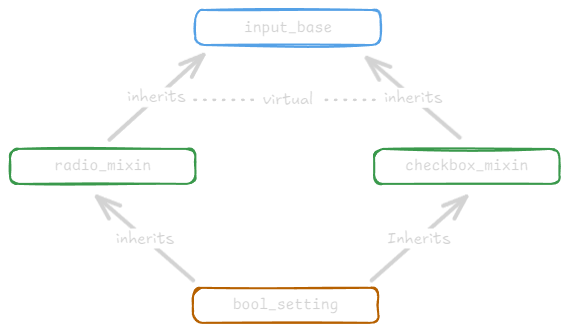Diamond “Problem” and Virtual Inheritance
As explained in my previous blog post, I used mixins for a cleaner and more explicit widget/settings structure. But as you might’ve noticed, the mixins use virtual inheritance:
struct radio_mixin : virtual input_base {
as_radio() {set_input(input_type::Radio); }
};
The reason for this is, without it, it would run into the Diamond Problem.
Let’s say we have this code, same as before (simplified) but without the virtuals:
/* Base */
struct input_base {
input_type type;
void set_input(const input_type v) { type = v; }
input_type_widget get_input_type() { return type; }
}
/* Mixins */
struct radio_mixin : input_base {
as_radio() {set_input(input_type::Radio); }
};
struct checkbox_mixin : input_base {
as_checkbox() {set_input(input_type::Checkbox); }
};
struct bool_settings : radio_mixin, checkbox_mixin {
};
bool_settings inherits from both radio_mixin and checkbox_mixin, which both inherit from input_base. This means, because both radio and checkbox inherit from input_base, bool settings technically has 2x input_base.

So if you would call bool_settings::set_input(...) or bool_settings::get_input_type() it would throw an ambiguous error because it doesn’t know which one it should call.
To solve this, you would have to make both mixins virtually inherit from input_base. This “combines” the 2 input_base classes together, and gives you:
struct radio_mixin : virtual input_base {
as_radio() {set_input(input_type::Radio); }
};
struct checkbox_mixin : virtual input_base {
as_checkbox() {set_input(input_type::Checkbox); }
};

This Diamond “problem” helped me make my code a lot cleaner. No matter which mixin the type setting would inherit from, they all change the same type property.
